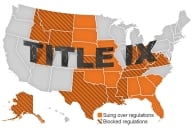You have /5 articles left.
Sign up for a free account or log in.

Justin Sullivan/Staff/Getty Images News
Californians face persistent equity gaps in gaining admission to the University of California and California State University systems, according to a new report by the Campaign for College Opportunity, an advocacy and research organization based in the state and focused on expanding college access and completion.
The report, which was released today, says the demand to attend these institutions among eligible students has outpaced the capacity of the colleges.
A quarter of high school graduates in the state applied to the UC system in 2020, an increase from 17 percent of high school graduates two decades ago. But the share of students admitted to the system has only increased slightly, from 15 percent to 17 percent, and the number of students enrolling in the system has held relatively steady at 8 percent.
The share of high school graduates applying to the CSU system has also increased to 36 percent in 2020 from 27 percent in 2001. The portion admitted grew from 20 percent to 32 percent during that time frame, and the share who enrolled also increased slightly, from 11 percent to 13 percent.
However, the number of eligible applicants exceeds the space and resources available at 16 of the 23 CSU campuses. The UC system has simultaneously become increasingly selective—the average high school GPA of students admitted to the system is now above 4.0 for nearly all UC campuses, compared to just three campuses in the 1990s.
“We’re shutting out capable, qualified, talented students from our university systems because we’re not keeping pace with the number of eligible students,” said Michele Siqueiros, president of the Campaign for College Opportunity. “We’re not funding sufficient spots in our universities for them, and that has an inequitable impact across the board in a state that’s incredibly diverse.”
Black and Latinx students experience stubborn disparities in admissions, the report details. Only 4.5 percent of freshmen in both the CSU and UC systems were Black in 2020, relative to 5.3 percent of high school graduates. Black students made up 7.2 percent of CSU freshmen in 2007.
While more than half of CSU freshmen, 54 percent, are Latinx—matching their share of high school graduates in the state—Latinx students remain “vastly underrepresented” in the UC system, despite record admissions, according to the report. The percentage of Latinx freshmen almost doubled from 15 percent in 1994 to 29 percent in 2020, but it lags in comparison to the proportion of Latinx high school graduates. Black and Latinx students are also largely concentrated on less selective campuses in the UC system, such as the University of California, Merced.
The report asserts that students of color are “winnowed out of the pathway to the UC and CSU beginning in the 9th grade” because of hurdles throughout the pipeline from high school to university. For example, only 31 percent of Black high school graduates and 36 percent of Latinx high school graduates completed the set of high school courses required for admission to universities in the state. Disparities in the availability of these courses and academic supports at K-12 schools across the state are partly to blame, the report notes.
“Students have unequal access to college preparation, and that varies based on race, ethnicity and low-income status,” Siqueiros said.
Siqueiros pointed out that, among Latinx high school graduates who are eligible, fewer than half apply to UC campuses, which leads to an even “smaller pool” going to college.
The ban on affirmative action in California is also cited by the report as a reason for continued equity gaps. An attempt to repeal the ban, which was implemented in 1996, and restore the right of public colleges and universities to consider race and ethnicity in admissions failed in 2020.
Universities used to be able to “tailor communications outreach at times to key communities of color,” said Manny Rodriguez, associate director of policy and government relations at the Education Trust–West, a research and advocacy organization focused on education in California. “You can’t address racial equity if you can’t even talk about race.”
The report calls on state lawmakers to set an official goal of 60 percent of Californians holding a degree or certificate by 2030 and to increase funding to the UC and CSU systems so they can accommodate more students. It notes that the portion of the state budget invested in higher education decreased from a peak of 18 percent in the mid-1970s to 11 percent in the 2018–19 fiscal year.
Governor Gavin Newsom notably signed into law in October a $47.1 billion package of bills to support higher education.
“We’re turning commitments into reality by ensuring that our students have more access to high-quality educational opportunities, creating a change of course for generations to come and bolstering California’s innovation economy,” he said in a press release announcing the signing of the legislation. “Californians have thrived at our world class universities for decades, but not everyone has had similar access—today that’s changing.”
The state budget passed in July also declared an "intent" to put new funds toward enrollment in 2022-23, but the funding will depend on appropriations in the next budget cycle.
Mike Uhlenkamp, a spokesperson at the CSU system chancellor’s office, said that funding dedicated to increasing enrollment is critical to ensure CSU campuses can not only enroll more students but provide them with the supports they need to graduate.
“It comes down to can we get funding to increase this enrollment,” he said. “The last thing we want to do is open the doors and not let students get through, and by that I mean welcoming them in but not ensuring they can be successful while they’re here.”
While the UC system traditionally draws its freshman class from the top one-eighth of high school graduates in the state and the CSU system from the top one-third, the report suggests that students from the top 15 percent of high school graduates should be considered eligible for the UC system and the top 40 percent eligible for the CSU system. It simultaneously recommends getting rid of standardized testing requirements in order to close equity gaps in admissions.
The report also suggests possible ways the state’s higher education systems could serve more students, including expanding current facilities, building new branch campuses, offering more courses and programs online, or creating more bachelor’s degree programs at community colleges.
“California needs to have a serious conversation about how it’s going to meet enrollment demands moving forward,” Rodriguez said. “Incremental enrollment budget increases are not going to work moving forward, and they’re not working.”









